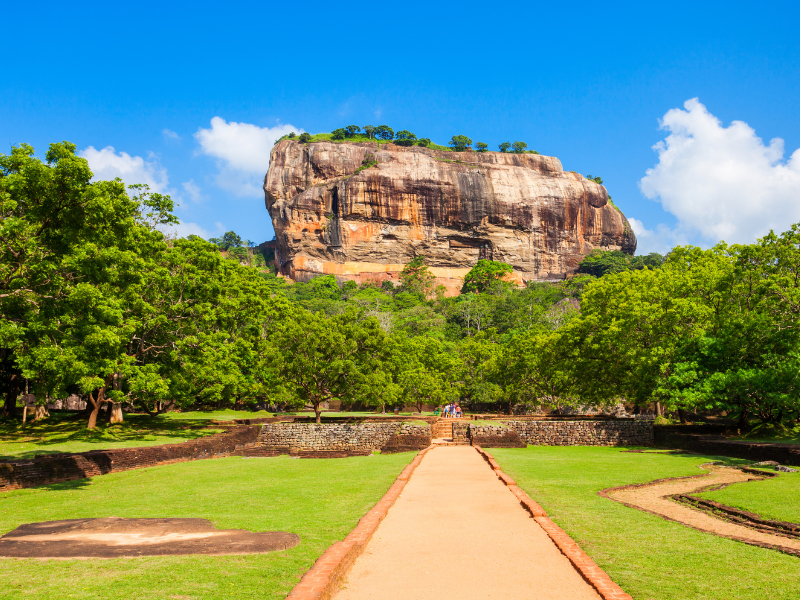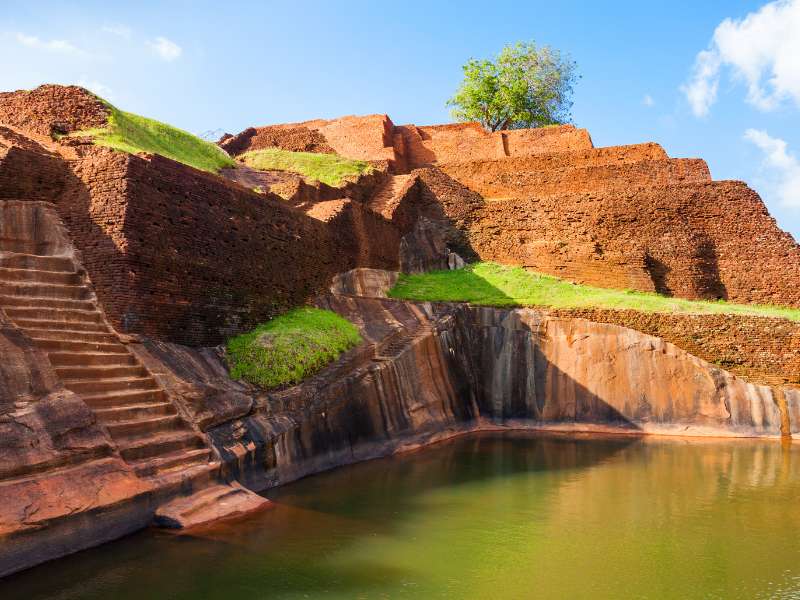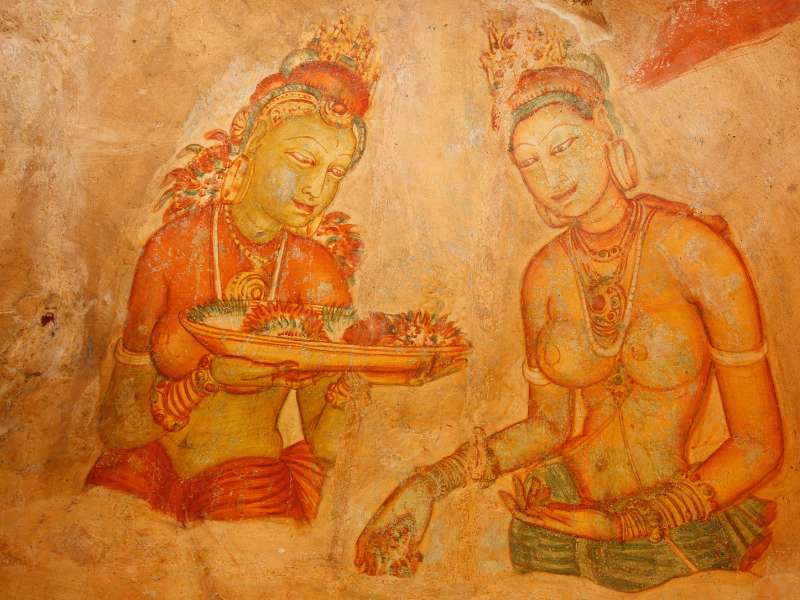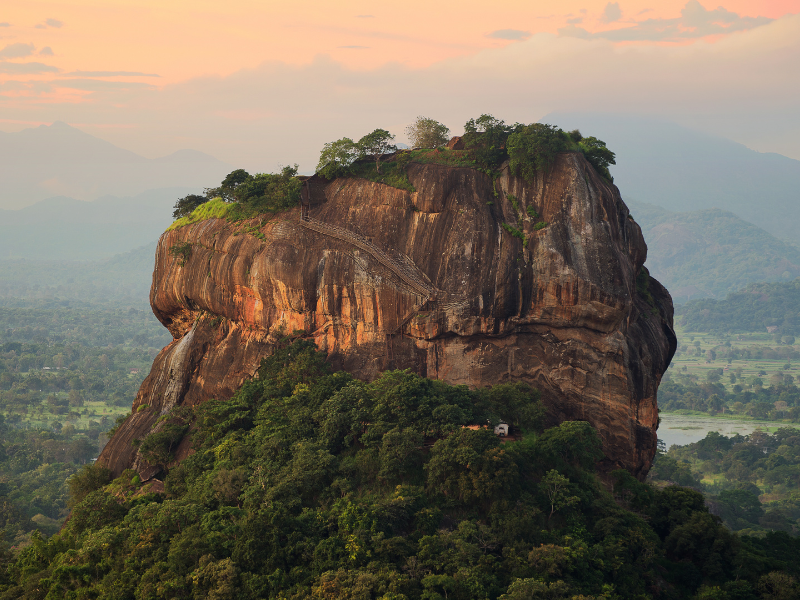I. Introduction
Sigiriya, a name that evokes wonder and mystique, stands as a testament to the ingenuity and grandeur of ancient Sri Lankan civilization. Tucked away amidst the verdant plains of Sri Lanka’s cultural triangle, this UNESCO World Heritage Site is not merely a fortress or a palace; it is a living testament to the artistic, architectural, and cultural brilliance of its creators. Rising majestically from the surrounding landscape, Sigiriya’s imposing presence beckons travellers from across the globe to unravel its secrets and bask in its timeless beauty.
As we embark on this journey to explore the wonder of Sigiriya, it’s essential to understand the significance of this iconic landmark. For centuries, Sigiriya has captivated the imagination of poets, scholars, and travellers, drawing them into its mystical embrace with promises of ancient legends and hidden treasures. Its sheer rock face, adorned with vibrant frescoes and flanked by lush gardens and water features, paints a picture of opulence and grandeur that belies its tumultuous history.
But beyond its physical splendour, Sigiriya holds a deeper significance as a symbol of Sri Lanka’s rich cultural heritage and artistic legacy. It serves as a reminder of the island’s ancient civilizations, their triumphs, and their tragedies, offering a glimpse into a bygone era of glory and greatness. Through its towering rock fortress, intricate murals, and intricate water gardens, Sigiriya whispers tales of kings and kingdoms, conquests and conflicts, leaving an indelible mark on the fabric of Sri Lankan history.
As we embark on our exploration of Sigiriya, let us open our hearts and minds to the wonders that await us. Let us immerse ourselves in its timeless beauty, uncover its hidden treasures, and pay homage to the artisans and architects who crafted this masterpiece of human achievement. In Sigiriya, we discover not only a monument to the past but also a beacon of inspiration for generations to come.
II. Historical Background
To truly appreciate the wonder of Sigiriya, it’s essential to delve into its rich historical background. Sigiriya’s story begins over two millennia ago, during the reign of King Kashyapa in the 5th century AD. Seeking refuge and fearing reprisal from his half-brother, King Kashyapa chose the site of Sigiriya to construct a fortress-palace that would serve as both a sanctuary and a symbol of his power.

The construction of Sigiriya was a monumental undertaking, reflecting the king’s ambition and desire to create an impregnable stronghold that would rival any in the ancient world. The fortress was built atop a massive granite rock formation, rising 200 meters above the surrounding plains, providing a natural defence against would-be invaders. The ascent to the summit was fraught with peril, with narrow staircases, hidden passageways, and elaborate defences designed to thwart any assault.
However, King Kashyapa’s reign and the glory of Sigiriya were short-lived. Following his defeat at the hands of his half-brother and rightful heir to the throne, King Moggallana, Sigiriya was abandoned and eventually fell into ruin. For centuries, it lay forgotten, reclaimed by the dense jungle that engulfed its once-majestic structures.
It wasn’t until the 19th century that Sigiriya’s true significance was rediscovered by British archaeologists, who marvelled at the architectural marvels hidden amidst the overgrown foliage. Since then, Sigiriya has been painstakingly restored and preserved, allowing visitors from around the world to marvel at its ancient beauty and unravel the mysteries of its past.
Today, Sigiriya stands as a testament to the vision and ambition of its creators, a living monument to the ancient civilizations that once flourished on the island of Sri Lanka. Its towering rock fortress and intricate frescoes continue to captivate the imagination of all who gaze upon them, offering a glimpse into a bygone era of glory and greatness. As we explore Sigiriya’s historical background, we gain a deeper appreciation for the enduring legacy of this iconic landmark and the people who called it home.
III. Architectural Marvels
Sigiriya’s architectural marvels stand as a testament to the ingenuity and craftsmanship of ancient Sri Lankan artisans. From the moment visitors set foot on its grounds, they are greeted by a spectacle of grandeur and opulence that leaves a lasting impression.
The Lion Rock:
The centrepiece of Sigiriya’s architectural ensemble is undoubtedly the Lion Rock, a towering monolith that rises majestically from the surrounding landscape. At its base, visitors are greeted by two gigantic lion paws, remnants of a once-magnificent lion statue that guarded the entrance to the royal palace atop the rock. The ascent to the summit is a feat of engineering prowess, with a series of staircases, galleries, and terraces carved directly into the rock face, offering breathtaking views of the surrounding countryside.

The Water Gardens:
Descending from the summit of the Lion Rock, visitors are greeted by the lush greenery and tranquil waters of Sigiriya’s Water Gardens. These meticulously landscaped gardens feature a network of ponds, canals, and fountains that once served as both a source of irrigation and a symbol of the king’s wealth and power. Adorned with intricate sculptures, terraced gardens, and exotic flora, the Water Gardens provide a peaceful oasis amidst the rugged terrain of Sigiriya.
The Frescoes of Sigiriya:
One of Sigiriya’s most iconic features is its vibrant frescoes, which adorn the walls of a sheltered alcove halfway up the rock face. These ancient paintings depict celestial maidens, known as “apsaras,” in all their ethereal beauty, offering a glimpse into the artistic prowess of the ancient Sri Lankan civilization. Despite centuries of exposure to the elements, the frescoes remain remarkably well-preserved, their vivid colours and intricate details captivating the imagination of all who behold them.
As visitors explore Sigiriya’s architectural marvels, they are transported back in time to an era of grandeur and sophistication. Each structure and sculpture tells a story of kings and kingdoms, conquests and conflicts, leaving an indelible mark on the landscape and the hearts of all who visit. Indeed, Sigiriya’s architectural wonders stand as a testament to the enduring legacy of Sri Lanka’s ancient civilization, a legacy that continues to inspire awe and admiration to this day.
IV. Cultural Significance
Sigiriya’s cultural significance transcends its architectural splendour, embodying the essence of Sri Lanka’s rich heritage and artistic legacy. As visitors traverse its hallowed grounds, they are immersed in a tapestry of history, mythology, and spiritual symbolism that reflects the island’s diverse cultural tapestry.
Symbol of Power and Prestige:
Sigiriya served as more than just a royal residence; it was a symbol of power and prestige, a testament to the authority and ambition of its creators. For King Kashyapa, the construction of Sigiriya was not merely an architectural endeavour but a statement of his prowess as a ruler, a declaration to the world of his dominance over the land. The grandeur of Sigiriya’s architecture and the intricacy of its design speak volumes about the opulence and sophistication of ancient Sri Lankan civilization, leaving an indelible mark on the island’s cultural landscape.
Artistic Masterpiece:
At the heart of Sigiriya’s cultural significance lies its status as an artistic masterpiece, a testament to the creativity and ingenuity of its creators. From the vibrant frescoes that adorn its rock face to the intricate carvings that adorn its walls, every inch of Sigiriya bears the imprint of ancient Sri Lankan craftsmanship. These artistic treasures not only showcase the technical skill of their makers but also offer insights into the beliefs, values, and aspirations of the people who called Sigiriya home. Through their vibrant colours and intricate details, the frescoes and sculptures of Sigiriya serve as windows into a bygone era, transporting visitors to a world of myth and legend.
Spiritual Sanctuary:
Beyond its role as a royal citadel, Sigiriya held immense spiritual significance for the people of ancient Sri Lanka. It was believed to be a sacred site, imbued with divine energy and mystical power. The rock itself was regarded as a symbol of Mount Meru, the mythical abode of the gods, while the surrounding landscape was seen as a manifestation of the earthly realm. For pilgrims and devotees, ascending Sigiriya was not just a physical journey but a spiritual odyssey, a quest for enlightenment and transcendence.
Legacy of Inspiration:
Today, Sigiriya continues to inspire awe and admiration among visitors from around the world, its cultural significance transcending time and space. As a UNESCO World Heritage Site, it stands as a testament to the enduring legacy of Sri Lanka’s ancient civilization, a legacy that continues to shape the island’s cultural identity to this day. From artists and scholars to historians and travellers, Sigiriya serves as a source of inspiration and wonder, reminding us of the profound beauty and richness of human creativity.
In essence, Sigiriya’s cultural significance lies not only in its architectural splendour but also in its ability to connect us to the past, present, and future. As we explore its hallowed grounds, we are reminded of the enduring legacy of Sri Lanka’s ancient civilization and the timeless beauty of its cultural heritage.
V. The Legend of Sigiriya
The legend of Sigiriya is steeped in myth and folklore, adding an extra layer of mystique to its already enchanting allure. As visitors traverse its ancient pathways and towering rock fortress, they are transported back in time to a world of myth and legend, where gods and mortals walk the earth as equals.
The Tale of King Kashyapa:
Central to the legend of Sigiriya is the story of King Kashyapa, the ambitious ruler who sought to carve out his legacy amidst the rugged plains of ancient Sri Lanka. Fearing reprisal from his half-brother and rightful heir to the throne, King Moggallana, Kashyapa chose the site of Sigiriya to construct a fortress-palace that would serve as both a sanctuary and a symbol of his power. Legend has it that he spared no expense in its construction, employing the finest craftsmen and artisans from across the land to realize his vision of grandeur and opulence.
The Divine Inspiration:
According to legend, the creation of Sigiriya was not merely a human endeavour but a divine inspiration. It is said that King Kashyapa was guided by celestial beings, who whispered secrets of architecture and design into his ear as he slept. These divine visions fueled his ambition and drove him to create a monument that would stand as a testament to his greatness for all eternity.
The Curse of Sigiriya:
But with greatness comes tragedy, and the legend of Sigiriya is no exception. It is said that King Kashyapa’s reign was marked by betrayal and bloodshed, as he sought to cement his grip on power at any cost. Legend has it that the spirits of those who perished at his hand still haunt the halls of Sigiriya, their restless souls seeking vengeance against their tyrannical ruler. Some believe that the curse of Sigiriya still lingers to this day, casting a shadow over all who dare to tread its ancient pathways.
The Legacy of Sigiriya:
Despite its tumultuous past, Sigiriya endures as a symbol of resilience and endurance, a testament to the indomitable spirit of the human soul. Its towering rock fortress and intricate frescoes continue to captivate the imagination of all who behold them, offering a glimpse into a world of myth and legend that refuses to be forgotten. As visitors explore its hallowed grounds, they are reminded of the timeless beauty and profound significance of Sri Lanka’s ancient heritage, a legacy that continues to inspire awe and wonder to this day.
VI. Sigiriya Today: Conservation Efforts and Tourism
In the modern era, Sigiriya stands not only as a historical relic but also as a living testament to the importance of conservation efforts and sustainable tourism practices. As one of Sri Lanka’s most iconic landmarks, Sigiriya attracts visitors from around the world eager to explore its ancient wonders and unravel its mysteries. However, with increased foot traffic and environmental pressures, the need for responsible stewardship of this cultural treasure has never been more pressing.

Preserving the Past:
At the heart of Sigiriya’s conservation efforts is a commitment to preserving its rich heritage for future generations. Government agencies, local communities, and international organizations have joined forces to safeguard Sigiriya’s archaeological sites, ancient structures, and delicate ecosystems. Through meticulous restoration projects and ongoing research initiatives, efforts are underway to ensure that Sigiriya’s cultural and natural treasures remain intact for years to come.
Sustainable Tourism Practices:
In recent years, there has been a growing emphasis on promoting sustainable tourism practices at Sigiriya and its surrounding areas. Tour operators, hotels, and local businesses are increasingly embracing eco-friendly initiatives, such as waste management, energy conservation, and community engagement programs. By minimizing the ecological footprint of tourism activities and supporting local conservation efforts, stakeholders are working together to ensure that Sigiriya remains a sustainable and responsible destination for travellers.
Visitor Education and Awareness:
Another crucial aspect of Sigiriya’s conservation efforts is visitor education and awareness. Interpretive signage, guided tours, and educational programs are being implemented to educate visitors about the significance of Sigiriya’s cultural heritage and the importance of responsible tourism practices. By fostering a deeper appreciation for the site’s history and ecology, these initiatives empower visitors to become stewards of Sigiriya’s preservation and advocates for sustainable travel.
Challenges and Opportunities:
Despite the progress made in conserving Sigiriya, numerous challenges remain, including urban encroachment, illegal excavation, and climate change. However, these challenges also present opportunities for innovation and collaboration. By harnessing the power of technology, community engagement, and international cooperation, stakeholders can overcome these obstacles and ensure the long-term sustainability of Sigiriya as a cultural and natural treasure.
Looking to the Future:
As we look to the future, the conservation of Sigiriya serves as a model for heritage preservation and sustainable tourism worldwide. By prioritizing the protection of its cultural and natural resources, Sigiriya demonstrates the profound impact that responsible stewardship can have on preserving our shared heritage for generations to come. Through continued collaboration and commitment, we can ensure that Sigiriya remains a beacon of inspiration and wonder for centuries to come.
VII. Beyond Sigiriya: Exploring the Surrounding Area
While Sigiriya’s towering rock fortress and ancient ruins may take centre stage, the surrounding area is also teeming with cultural and natural wonders waiting to be discovered. From ancient temples and lush jungles to vibrant markets and serene lakes, the region offers a diverse array of attractions that appeal to travellers of all interests.
1. Dambulla Cave Temple:
Just a short distance from Sigiriya lies the Dambulla Cave Temple, a UNESCO World Heritage Site renowned for its ancient rock cave temples and stunning frescoes. Dating back over 2,000 years, these cave temples house hundreds of Buddha statues and intricate murals that offer insights into Sri Lanka’s rich Buddhist heritage.
2. Minneriya National Park:
Nature enthusiasts won’t want to miss the opportunity to visit Minneriya National Park, home to a diverse array of wildlife, including elephants, leopards, and sloth bears. The park is best known for its annual gathering of elephants, known as “The Gathering,” where hundreds of these majestic creatures congregate around the park’s central reservoir.
3. Pidurangala Rock:
For those seeking adventure and panoramic views, a hike up Pidurangala Rock provides an alternative perspective of Sigiriya and its surrounding landscape. While not as famous as its counterpart, Pidurangala offers fewer crowds and equally breathtaking vistas of the countryside below.
4. Polonnaruwa Ancient City:
History buffs will delight in exploring the ancient city of Polonnaruwa, a UNESCO World Heritage Site that served as the second capital of ancient Sri Lanka. Here, visitors can marvel at well-preserved ruins of temples, palaces, and dagobas dating back to the 12th century, offering a glimpse into the island’s storied past.
5. Spice Gardens and Markets:
No visit to the region would be complete without sampling the vibrant flavours and fragrances of Sri Lanka’s spices. Visitors can explore local spice gardens and markets, where they can learn about the cultivation and uses of spices such as cinnamon, cardamom, and cloves, and purchase high-quality spices to take home as souvenirs.
6. Kaudulla National Park:
Another wildlife sanctuary worth exploring is Kaudulla National Park, known for its abundant birdlife and picturesque landscapes. Visitors can embark on safari adventures to spot a variety of bird species, including painted storks, pelicans, and herons, as well as other wildlife such as deer, wild boar, and crocodiles.
7. Local Villages and Cultural Experiences:
For a deeper immersion into local culture and traditions, visitors can opt for village tours and cultural experiences offered by local communities. These experiences often include interactions with villagers, traditional meals, and demonstrations of traditional crafts such as pottery-making and weaving.
In conclusion, the surrounding area of Sigiriya offers a wealth of attractions and experiences that complement the main attraction. Whether exploring ancient temples, encountering wildlife in national parks, or immersing oneself in local culture, visitors to the region are sure to be captivated by its diverse offerings and rich heritage.
VIII. Conclusion: Sigiriya – A Timeless Wonder
As our journey through the wonder of Sigiriya comes to a close, we are left in awe of the timeless beauty and profound significance of this ancient marvel. From its towering rock fortress to its vibrant frescoes and lush gardens, Sigiriya stands as a testament to the ingenuity, creativity, and resilience of the ancient Sri Lankan civilization.
But Sigiriya is more than just a relic of the past; it is a living testament to the enduring legacy of Sri Lanka’s rich cultural heritage. Through centuries of tumultuous history and environmental challenges, Sigiriya has stood the test of time, inspiring awe and admiration in all who behold its splendour.
As we reflect on our exploration of Sigiriya, we are reminded of the importance of preserving our shared heritage for future generations. Through conservation efforts, sustainable tourism practices, and community engagement, we can ensure that Sigiriya continues to captivate the hearts and minds of travellers from around the world for centuries to come.
In the end, Sigiriya is more than just a rock fortress or a tourist attraction; it is a symbol of resilience, beauty, and human achievement. It serves as a beacon of inspiration and wonder, inviting us to delve into its ancient mysteries and uncover the secrets of the past. As we bid farewell to Sigiriya, we carry with us memories of its majestic beauty and timeless allure, forever etched in our hearts and minds.
Sigiriya – a timeless wonder that continues to inspire and enchant us, beckoning us to explore its ancient mysteries and bask in its enduring splendour.
IX. FAQ Section
1. How long does it take to climb Sigiriya?
– The ascent to the summit of Sigiriya typically takes around 1.5 to 2 hours, depending on your fitness level and pace. However, it’s essential to factor in additional time for exploring the rock fortress and its surrounding attractions.
2. Is Sigiriya suitable for children and elderly visitors?
– While Sigiriya offers a fascinating experience for visitors of all ages, the steep staircases and uneven terrain may pose challenges for young children and elderly individuals. It’s advisable to assess your physical abilities and consider your comfort level before embarking on the climb.
3. What is the best time of day to visit Sigiriya?
– The early morning hours or late afternoon are generally considered the best times to visit Sigiriya, as the temperatures are cooler, and the crowds are fewer. Additionally, witnessing the sunrise or sunset from the summit offers breathtaking views of the surrounding landscape.
4. Are there entrance fees for visiting Sigiriya?
– Yes, there are entrance fees for visiting Sigiriya, which vary depending on your nationality. Visitors are required to purchase tickets at the entrance gate, and fees may include additional charges for cameras and video equipment.
5. Are guided tours available at Sigiriya?
– Yes, guided tours are available at Sigiriya and are highly recommended for a more enriching experience. Knowledgeable guides can provide insights into the site’s history, architecture, and significance, enhancing your visit and helping you navigate the complex terrain.
6. Are there restroom facilities and refreshments available at Sigiriya?
– Yes, there are restroom facilities and refreshment stalls available at Sigiriya for visitors’ convenience. However, it’s advisable to carry water and snacks, especially if you plan to spend an extended period exploring the site.
7. Is photography allowed at Sigiriya?
– Yes, photography is allowed at Sigiriya for personal use. However, additional fees may apply for professional photography or videography, so be sure to check with the authorities before capturing images or footage.
8. What should I wear when visiting Sigiriya?
– It’s recommended to wear comfortable clothing and sturdy footwear suitable for walking and climbing. Additionally, it’s advisable to bring a hat, sunscreen, and insect repellent, especially during the warmer months. Dressing modestly is also respectful when visiting religious sites within Sigiriya.

